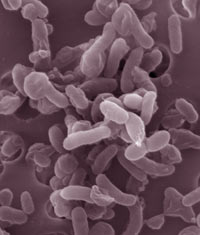
Scanning electron micrograph of cells of Methylotenera mobilis strain JLW8 grown on methylamine. Photo: Dennis Kunkel, Dennis Kunkel Microscopy, Inc.
Metabolism of organic C1 compounds (compounds containing no carbon-carbon bonds) is an important part of the global carbon cycle. Methane has been recognized as one of the major C1 compounds in the environment and a major contributor to the greenhouse effect. While global emissions of other C1 compounds (methanol, methylated amines) have historically attracted less attention, recent models put their emissions on a scale similar to the scale of methane emissions. JGI plans to sequence three methylotrophs (degraders of C1 compounds) of the genus Methylotenera.
Methylotrophic bacteria play a major role in maintaining the balance of C1 compounds in aerobic (oxygenated) environments. They are ubiquitous and are found across a range of oxygen tension, salinity, pH, and temperature. Methylotrophy is also widespread across bacterial groups and is found in alpha, beta, and gamma Proteobacteria; in Gram- positive bacteria; and recently in Verrucomicrobia. In addition to their role in natural environmental processes, methylotrophs have potential in bioremediation of environmental pollutants such as chlorinated solvents and methyl tert-butyl ether (MTBE).
This work follows previous work by JGI in sequencing methylotrophic communities from Lake Washington. Sequencing members of the Methylotenera will enable genome-wide comparisons within a single family (Methylophilaceae) and across phyla. The datasets generated in this project will also be invaluable for JGI, as these will allow comparisons between metagenomic Methylotenera scaffolds and the finished genomes, as a way to test and validate the tools currently used for assembly, quality control and analysis of metagenomic data.
Principal Investigators: Ludmila Chistoserdova and Marina G. Kalyuzhnaya (Univ. of Washington), and Alla Lapidus (DOE JGI).
Program: CSP 2009